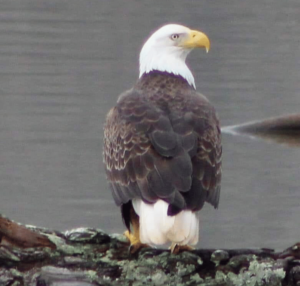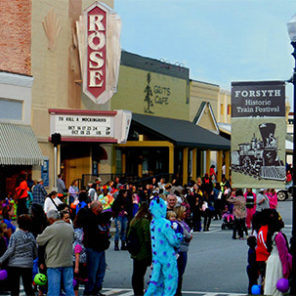
Few moments are more awe-inspiring than witnessing Bald Eagles soaring gracefully overhead or perched on branches. The Bald Eagle (Haliaeetus leucocephalus) is a beautifully magnificent bird of prey native to North America and serves as our national bird and symbol of the United States. In fact, Bald Eagles are found in every U.S. state except Hawaii.
Just up the road from Forsyth, Rum Creek Wildlife Management Area at Lake Juliette offers surprising opportunities for bird photographers and enthusiasts. Bald Eagles can be spotted here year-round due to the milder climate and abundant food sources. Eagles prefer proximity to bodies of water such as rivers and lakes, making Dames Ferry and Lake Juliette, plus High Falls Lake and Lake Jackson, prime locations. Eagle-spotting is a thrilling and educational experience, but knowing where to go can be challenging. Having them so nearby is indeed a treat!
Here are some fascinating facts about these incredible creatures:
Did you know Bald Eagles build large nests called eyries or aeries? They prefer to nest in tall trees near water, often selecting areas with minimal human disturbance and good visibility to monitor their surroundings and protect their nests. These nests are substantial structures of sticks lined with soft materials like grass, moss and feathers. Bald Eagles reuse their nests year after year, adding new materials and expanding the structure.
Did you know Bald Eagles are opportunistic hunters and feed primarily on fish? However, they are also known to scavenge and eat carrion of other animals. Their diet may include waterfowl, small mammals, amphibians, reptiles, and occasionally, other birds. The availability of fish-rich habitats is crucial for their survival and reproductive success.
Did you know immature Bald Eagles are cloaked in a chocolate-brown color that gradually transforms into the iconic adult coloration as they mature? Mature Bald Eagles can be easily recognized by their distinctive appearance, with the characteristic white head and tail contrasting against a dark brown body.
Did you know conservation efforts also focus on these young Bald Eagles since preserving trees used by young birds for roosting favors their survival and growth into majestic national icons?
Did you know Bald Eagles boast an impressive wingspan but also a curved bill and clawed feet perfect for hunting prey around regions with open water?
Did you know that harassing or disturbing a Bald Eagle is a federal offense carrying severe penalties?
Each year on January 10th, Save the Eagles Day reminds us of the majestic raptors that soar above the Earth – whether they are well-populated or endangered. Due to the work of scientists and the public, the Bald Eagle was removed from this list in June 2007. But poaching, pesticides, and other dangers continue to threaten Eagle populations.
Respect for the majestic Bald Eagle extends beyond mere admiration. As watchers gaze upon them, understanding the Bald Eagle’s vital role can help enhance appreciation while ensuring environmental protection measures continue to be upheld across prime Eagle habitats. Recognizing a Bald Eagle’s importance and uniqueness enriches your bird-watching experience and contributes positively to conservation efforts. We invite you to observe these fascinating creatures on your next trip to Forsyth and the surrounding area. Happy Eagle-spotting!




